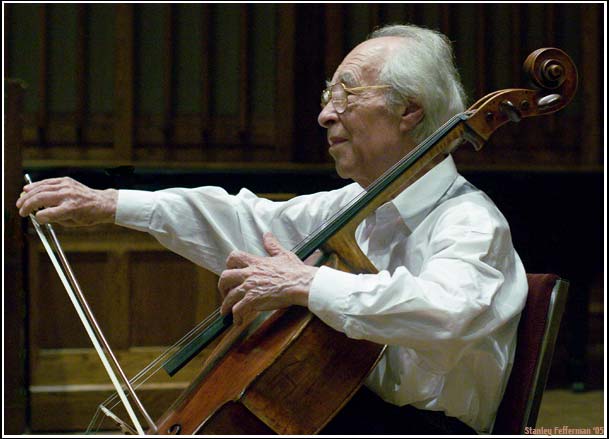The Borodin is one of the world’s premiere quartets, and their association with Shostakovich’s string quartets is special. Says Berlinsky:”We always presented them to him [Shostakovich] before we played them in public, just to have his final blessing. He never spoke about the meaning, but we were 100 per cent sure of what we were playing.” Shostakovich wrote an ecstatic response to the Borodins after their first complete recording of the string quartets, expressing his gratitude for their ‘magnificent performance’ that displayed their ‘brilliant mastery.’
This year, the Borodin is in Ottawa, bringing their absolute confidence to bear in a five-concert traversal of the entire cycle of 15 Shostakovich quartets. Their first performance included numbers 2, 1, and 3.
The String Quartet No. 2 in A major begins in discord, strife and a tension that could set your teeth on edge. The dark mahogany tones of Berlinsky’s cello produce a drone behind the recitative of the first violin that sounds like a voice crying in the wilderness and fading into the silence of the grave. The later movements develop the energy of a runaway locomotive and feature tonally perfect viola solos by Igor Naidin which bring the final movement’s up-tempo folkdance to a solemn and majestic close.
String Quartet No. 1 in C major is lighthearted and nostalgic with a sense of journey through a bee-filled pastoral landscape, sprightly, soft and pure as youth, that builds towards a final movement filled with Bartokian complexity and urgency, as if the world of responsibility were breaking through and imposing tasks loom ahead.
In String Quartet No. 3 in F major, the pastoral themes reappear in an even more lovely form, but strive with passages that recall the inexorable ticking of a clock and the wild forward rush of mechanical energy—tanks, tractors, turbines, and troop trains. The pastoral organic voice reappears in the final movement, seemingly purged of romantic notions, flowing energetically like a big river. The dualism of the themes are highlighted by the very last passage in which a seemingly endless drone sustained by the cello is the dark canvas on which the highest and purest silver strains of the violin aspire and fade away like the track of a bird in the night sky.
When The Borodin play Shostakovich, the music seems to bloom like a desert landscape during a rain.
The String Quartet No. 4 in D major, Op. 83 was composed in 1949 during Stalin’s last wave of terror, and was released only in 1953, 8 months after the dictator’s death. Shostakovich had been ‘officially’ attacked and disciplined during Stalin’s final terror, and it is said he sought refuge from depression by working on this quartet.
We hear, after a non-descript opening by two violins in unison, the low register strings set up a drone that grinds like a murmuring crowd being worked up and down by news of daily impositions. One feels transfixed by an odd sadness, like witnesses at a stranger’s funeral. The second movement is also subdued, relieved by a lyrical note of yearning for a better life. This brings a deep feeling of commiseration with a vast sadness that is carried on the outpouring of Belinsky’s cello.
The two final movements, played as one, introduce an edgy, pulsing, busy, metropolitan sound, complex and impersonal as traffic or the buzz of a hive. It rises towards a high-energy conclusion suggesting a broad and positive social vision. In the final moments of this quartet, the personal returns in an eerily high passage as the first violin shrills against a slow, sustained cello pizzicato and their combined voices fade out.
The String Quartet No. 6 in G major, Op. 101 dates from 1956, when Khrushchev was at the helm and the Party had reduced its scrutiny of culture. It is somewhat lightweight, though strains of personal melancholy and social survival issues underlie the sprightly dance tempos. The two final movements were played without a break allowing a mood of soulful introspection to pass into a squabbling hesitancy marked by sour comments from the cello. This mood runs out and the piece resolves into silence after a slow and disarming dance.
The highlight of the evening was the Borodin’s performance of the String Quartet No. 5 in B flat major, Op. 92, Shostakovich’s last quartet written during the Stalin era. There is a great struggle envisioned here, introduced by a five-note motif which the viola repeats doggedly. This motif is then enclosed by excruciatingly high notes of the first violin that join the three movements together.
Struggle can be heard in the juxtaposition of clamorous cries from the two violins and the organized, repetitious, mesmerizing drone of the cello and viola. The Borodin’s tonal control is unsurpassable. There is a trio section which sounds like the voice of a pipe organ. This passage caused one of the music critics in the balcony to lower the screen of his laptop.
The work proceeds gloriously in pin-drop silence depicting the beautiful release of spring thaw in a pastoral landscape as it coagulates into a rich orchestral passage like the reassertion of a huge reality after a pleasant dream. This fades into a dark waltz and the cello carries the final melody over the drone of violins into a peaceful close.


